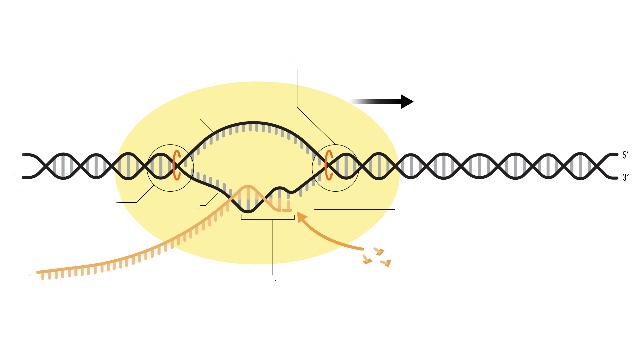Rna polymerase
Ribonucleic acid (RNA) polymerase is an intermediate enzyme responsible for the processing of gene sequences into RNA-based genetic material that can be used in protein synthesis. In this article, we define RNA polymerase and explore its various functions in cell biology.
What is RNA polymerase?
RNA polymerase is a multi-unit enzyme that synthesizes RNA molecules from a DNA template through a process called transcription. Transcription of genetic information into RNA is the first step in gene expression that precedes translation, the process of decoding RNA into proteins.
Structure and function of RNA polymerase (in transcription)
The RNA polymerase enzyme is a large complex made up of multiple subunits1. The prokaryotic form of RNA polymerase has four subunits capable of transcribing all types of RNA. In eukaryotes, these enzymes have eight or more subunits that facilitate DNA binding and processing throughout transcription.

The three stages of transcription involve various functions of RNA polymerase that result in RNA synthesis:
1. Initiation begins when RNA polymerase envelops the promoter region of DNA. The promoter is a DNA sequence that guides RNA polymerase on where to bind upstream of a gene. While prokaryotic RNA polymerase can bind directly to DNA promoter sequences, eukaryotic forms require the aid of transcription factors for initial binding. Once the RNA polymerase successfully binds to DNA in the target promoter region, the enzyme can proceed to the second stage of transcription.
2. Elongation begins when RNA polymerase unwinds double-stranded DNA into two single strands. These DNA strands are used as genetic templates for RNA synthesis. As the DNA template strand moves through the RNA polymerase, it builds an RNA strand that is complementary to the transcribed DNA strand.
3. Termination is the final step in transcription. Once RNA polymerase finds a termination sequence or signal, it stops adding complementary nucleotides to the RNA strand. This is followed by the release of the RNA transcript, which marks the end of the transcription of that DNA template.
What are the different types of RNA polymerase?
While prokaryotes, like bacteria, have an RNA polymerase that transcribes all types of RNA, eukaryotes, like plants and mammals, can have numerous forms of RNA polymerase.
RNA polymerase I
RNA polymerase I2 is responsible for synthesizing the majority of ribosomal RNA (rRNA) transcripts. These transcripts occur within the nucleolus, a region within the nucleus where ribosomes assemble. The availability of rRNA molecules produced by RNA polymerase can affect essential functions of cell biology, as these transcripts are directly involved with ribosome production.
RNA polymerase II
RNA polymerase II3 transcribes protein-encoding genes into messenger RNA (mRNA). This 12-subunit enzyme functions as a complex that directly influences gene expression through its production of pre-mRNA transcripts. Once the pre-mRNAs are released by RNA polymerase II within the nucleus, biochemical modifications prepare these transcripts for translation. RNA polymerase II also produces micro RNA molecules (miRNA). These non-coding transcripts can mediate gene expression and mRNA activity after transcription.
